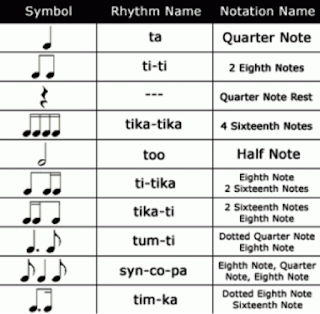Basic Music Theory - #2 - Clefs and Time Signatures
Welcome to Music Theory Post #2 on the Grand Staff, Clefs, and
Time Signatures, 3 incredibly important components of every musical
composition. I’ve included
illustrations, which will, hopefully aid your understanding and comprehension
of these concepts. Please check these
out and let me know what you think. Here
they are:
•
CLEFS AND
GRAND STAFF - When you SEE sheet music, the first thing you see are ten
lines, grouped and separated into two groups of five with spaces in
between. On the left-hand side, are the
Clefs. These denote where the notes are
to be played, which hand is to play which notes. The “top” Clef is called the “Treble” of “G”
Clef. You will see it below. Where you see the “Curl” on the Clef, there
is a line that runs through it. This is
the “G” line, the “G” above Middle “C”.
The Clef on the bottom is the “Bass” or “F” Clef. Modeled from a version of a Capital Cursive
“F”, where the letter would be crossed, there is a line (the second line from
the top of the staff) surrounded by a colon.
That line that passes between the dots is the “F” Note below Middle
“C”. The illustration of these are
below:
•
TIME
SIGNATURES - A time signature looks essentially like a fraction without
the dividing line. Its purpose is not to
provide the Tempo of the song but it DOES define how the song is to be counted,
as well as the count value for the notes included within the piece. The Time Signature is located at the
beginning of the first staff of a song, just AFTER the Clefs and the Key
Signature (we will talk about what this is in a later post). Here is an example of what it will look like:
The two numbers of a Time Signature stipulate two different,
important pieces of information about rhythm in that song.
The top number tells you how many beats will be in each
measure or bar. One “Bar” is all the
notes and rests (and possibly, lyrics) from the originating Clef, Key
Signature, and Time Signature up to the vertical line or Bar Line, or all the
information, Notes, and Rests BETWEEN two Bar Lines. This number will be
between 2 and 12, but most commonly, 2, 3, 4, or 6. The bottom number tells you the type
of Note that gets 1 count in each measure.
Notes are designated as “1” for Whole Note, though this will NEVER be on
the bottom of a Time Signature; “2”, where a Half Note gets 1 count; “4”, where
a Quarter Note gets 1 count; “8”, where an Eighth Note gets 1 count; or “16”,
where a sixteenth Note gets 1 count. It
is possible to see a “32” or a “64” but these only occur in extremely advanced
Classical music, so it is highly unlikely you would ever encounter these. The most common bottom numbers are 4, 8, and
16.
TIME
SIGNATURE ABBREVIATIONS - BECAUSE these two Time Signatures are SO
prevalent, composers have actually shortened the fraction even more. A Capital “C” for Common Time, and the same
“C” with a vertical line through it for Cut Time. The “C” is actually NOT for Common; it is a
nod to an old form of Music Theory Notation called Mensural Notation, and it is
an uncompleted circle. It is CALLED
Common Time though, because it is used for 4/4 time, which is, in fact, the
most common Time Signature. Cut Time is
just that. When Common Time is “cut” in
half, it becomes 2/2 time, and is, therefore written as a Capital “C” with a
Vertical line through it.
I’ve packed a LOT
of information into this post! It’s
probably way too much to take in and comprehend all in one sitting, but PLEASE
take your time; send me questions. Let
me repeat that, SEND ME QUESTIONS!!!
This IS a foreign language. There
are only SEVEN letters in the Musical Alphabet but like any other language,
there are plenty of rules, and nuances that you have to understand to interpret
the language correctly. We’ll build on
this information from here but, obviously, you have to understand all of this
before you can add anything to it.
Again, SEND ME ANY QUESTIONS, comments, or other suggestions; I’m here
for you, and no question is “dumb”.
Thanks for reading! If you have
any questions about me or my lessons, check out my website at www.SingitForward.net.
Thanks again! Sing it forward!








Comments
Post a Comment